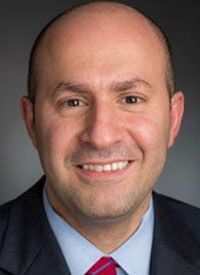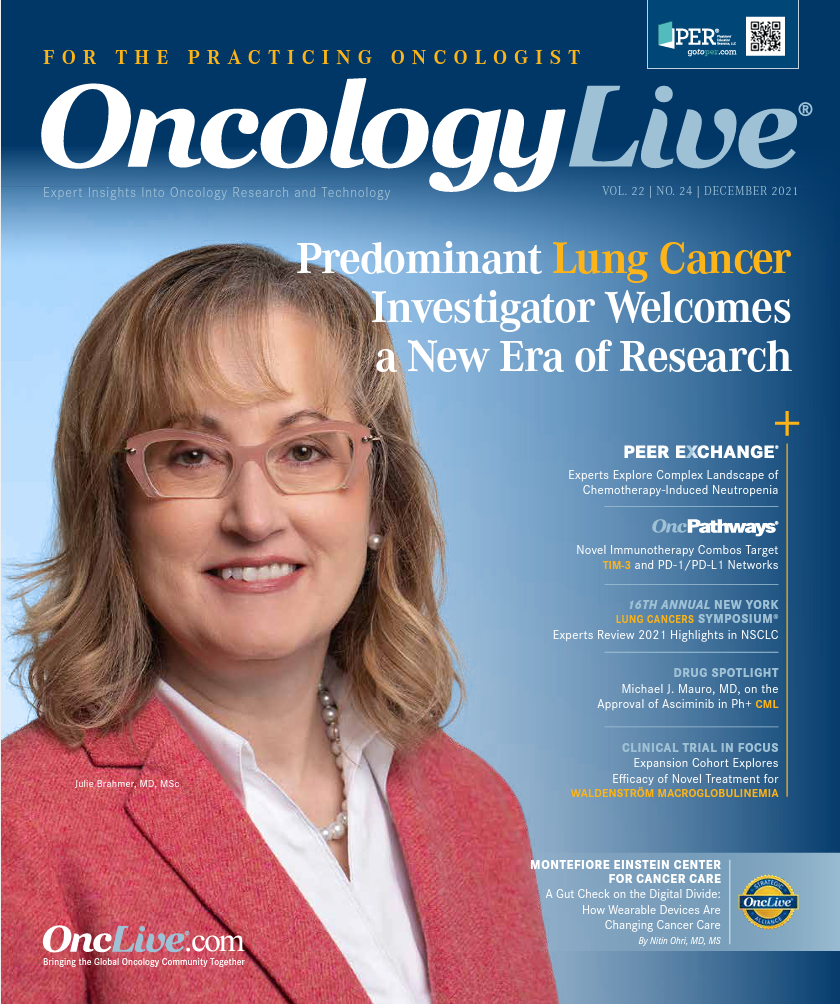Publication
Article
Oncology Live®
Pembrolizumab Proves Potential as New Standard of Care for RCC in Adjuvant Setting
Author(s):
Pembrolizumab demonstrated a statistically significant and clinically meaningful improvement in disease-free survival vs placebo as a postnephrectomy adjuvant therapy in patients with renal cell carcinoma at intermediate-high or high risk of recurrence, and in those who are M1 with no evidence of disease.
Toni K. Choueiri, MD

Pembrolizumab (Keytruda) demonstrated a statistically significant and clinically meaningful improvement in disease-free survival (DFS) vs placebo as a postnephrectomy adjuvant therapy in patients with renal cell carcinoma (RCC) at intermediate-high or high risk of recurrence, and in those who are M1 with no evidence of disease (NED), according to results from the phase 3 KEYNOTE-564 trial (NCT03142334).1
On November 17, 2021, the FDA approved the PD-1 inhibitor for this patient population following nephrectomy or following nephrectomy and resection of metastatic lesions.2
Results of an interim analysis of KEYNOTE-564 showed that of the 496 patients who received pembrolizumab, 109 patients (22%) had DFS events compared with 151 (30%) patients who received placebo (HR, 0.68; 95% CI, 0.53-0.87; P = .001). The median DFS had not yet been reached in either arm. Further, the 24-month DFS rates were 77% (95% CI, 73%-81%) vs 68% (95% CI, 64%-72%), respectively.3
An additional meaningful outcome measure was overall survival (OS). At the time of the interim DFS analysis, OS data were not mature, with 5% deaths in the overall population (N = 994). At a median follow-up of 24.1 months (range, 14.9-41.5), 3.6% of patients in the pembrolizumab arm had experienced an OS event vs 6.6% in the placebo arm (HR, 0.54; 95% CI, 0.30-0.96; P = .0164). The 24-month OS rates were 96.5% vs 93.5%, respectively.
KEYNOTE-564 is the first positive phase 3 study of adjuvant immunotherapy in RCC, according to principal investigator Toni K. Choueiri, MD, a 2021 Giants of Cancer Care® award winner in the genitourinary cancers category.
“We concluded in KEYNOTE-564 that the first adjuvant immunotherapy to be associated with a benefit is pembrolizumab in terms of DFS,” said Choueiri, director of the Lank Center for Genitourinary Oncology and director of the Kidney Cancer Center at Dana-Farber Cancer Institute in Boston, Massachusetts. “The benefit seemed to be consistent across subgroups despite [them being] small. We believe that pembrolizumab could become a standard of care in the adjuvant setting in RCC.”
Nephrectomy is currently the standard of care treatment for locoregional RCC.4 However, there is no globally accepted standard adjuvant therapy supported by high levels of evidence, according to Choueiri. Studies of adjuvant immunotherapy with cytokines have yielded negative results, and adjuvant VEGF-targeted therapy has not shown a consistent benefit.5,6
In the multicenter, randomized, double-blind, placebo-controlled KEYNOTE-564 trial, investigators assessed if treatment with pembrolizumab following nephrectomy led to significant changes in the 994 patients with clear cell RCC who are at intermediate-high or high risk of recurrence, and those who are M1 with NED.
The median age was 60 years in both the pembrolizumab (range, 27-81) and placebo arms (range, 25-84). At baseline, in the pembrolizumab arm, 427 patients (86.1%) were at intermediate-high risk of recurrence, 40 (8.1%) were at high risk, and 29 (5.8%) were M1 with NED. In the placebo arm, 433 patients (86.9%) were at intermediate-high risk, 36 (7.2%) were at high risk, and 29 (5.8%) were M1 with NED. Additionally, 459 patients (92.5%) had a radical nephrectomy in the investigative arm vs 460 (92.4%) in the control arm; 37 (7.5%) vs 38 patients (7.6%), respectively, had a partial nephrectomy.
Regarding PD-L1, in the pembrolizumab group 124 patients (25%) had a combined positive score (CPS) less than 1 and 365 (73.6%) had 1 or greater; the status was missing for 7 patients (1.4%). In the placebo group, 113 patients (22.7%) had a CPS less than 1, 383 (76.9%) had 1 or greater, and the status for 2 patients (0.4%) was missing.
The median time from randomization to cutoff was 24.1 months (range, 14.941.5). Patients were randomized 1:1 to receive 200 mg of pembrolizumab or placebo every 3 weeks until disease recurrence, unacceptable toxicity, or up to 12 months.
After 15 months of minimum follow-up, 260 DFS events occurred—78% of the number planned for the final analysis. Also, 51 OS events occurred—26% of what the number planned for the final analysis.
Investigators have planned additional follow-up to gather mature data from the key secondary end point of OS, according to Choueiri. “Unfortunately, [OS] only had 51 events, making it hard to have any power to connect OS benefits,” he said. “Even with what we saw—at 2 years a 3% difference favoring pembrolizumab, an absolute reduction in death, the hazard ratio of 0.54—we did not meet the stringent criteria for survival benefits. So we continue to follow up on survival.”
Regarding safety, results were in line with expectations and no new safety signals were observed, according to Choueiri. Treatment-related adverse events (TRAEs) occurred in 386 patients (79.1%) in the pembrolizumab arm and 265 patients (53.4%) in the placebo arm; specifically, 92 (18.9%) and 6 patients (1.2%), respectively, experienced grade 3 to 5 TRAEs. None of these TRAEs led to death. Commonly reported TRAEs in the pembrolizumab and placebo groups included fatigue (20.3% vs 14.3%), pruritus (18.6% vs 11.5%), hypothyroidism (17.6% vs 2.6%), diarrhea (15.8% vs 10.3%), and rash (15% vs 7.3%).
References
- Choueiri T, Tomczak P, Park SH, et al. Pembrolizumab (pembro) vs placebo as post nephrectomy adjuvant therapy for patients (pts) with renal cell carcinoma (RCC): randomized, double-blind, phase 3 KEYNOTE-564 study. J Urol. 2021;206(suppl 3):e1181. doi:10.1097/ JU.0000000000002150.01
- FDA approves pembrolizumab for adjuvant treatment of renal cell carcinoma. FDA. November 17, 2021. Accessed November 24, 2021. bit.ly/3CHZgG8
- Keytruda. Prescribing information. Merck; 2021. Accessed November 24, 2021. bit.ly/3oXbzt9
- NCCN. Clinical Practice Guidelines in Oncology. Kidney cancer, version 3.2022. Accessed November 24, 2022. bit.ly/3CIChe4
- Smaldone MC, Fung C, Uzzo RG, Haas NB. Adjuvant and neoadjuvant therapies in high-risk renal cell carcinoma. Hematol Oncol Clin North Am. 2011;25(4):765-791. doi:10.1016/j.hoc.2011.06.002
- Sun M, Marconi L, Eisen T, et al. Adjuvant vascular endothelial growth factor-targeted therapy in renal cell carcinoma: a systematic review and pooled analysis. Eur Urol. 2018;74(5):611-620. doi:10.1016/j.eururo.2018.05.002
























%20(2)%201-Recovered-Recovered-Recovered-Recovered-Recovered-Recovered-Recovered-Recovered-Recovered-Recovered-Recovered-Recovered-Recovered-Recovered-Recovered-Recovered-Recovered.jpg?fit=crop&auto=format)
%20(2)%201-Recovered-Recovered-Recovered-Recovered-Recovered-Recovered-Recovered-Recovered-Recovered-Recovered-Recovered-Recovered-Recovered-Recovered-Recovered-Recovered-Recovered.jpg?fit=crop&auto=format)
